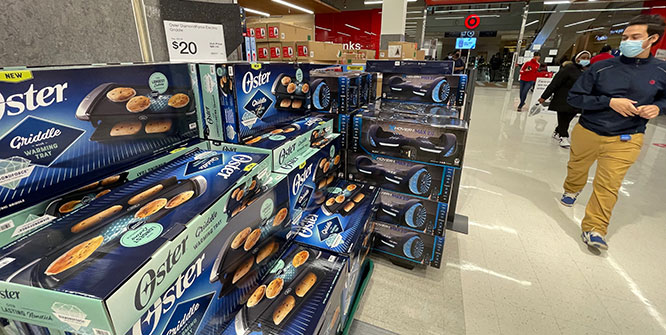
Photo: RetailWire
June 7, 2022
Target isn’t wasting any time in cutting the glut from its inventory
Target is serious about getting its inventory in order. The retailer today said it would markdown merchandise and cancel orders in an effort to right size its inventory, even though it will take a big hit to profit margins.
The chain’s first quarter operating income margin rate was 5.3 percent, down from 9.8 percent in 2021. Target ended the quarter with inventory about 43 percent higher than the same period last year.
The company lowered its forecast for the second quarter while at the same time emphasizing this short term response as a means to sustainable growth. The chain expects an operating margin of around two percent in the second quarter, rising to six percent in the second half of the year. It projects sales growth in the mid- to single-digit range.
The chain’s revised outlook forecasts continued growth in the beauty, food and beverage, and household essentials categories. The company expects that discretionary categories, including home, will be challenged.
The retailer said it was “pursuing aggressive options” to reign in expenses. These include working with vendors to address rising costs, building on operational efficiencies and finding other savings while seeking to maintain the customer experience in stores and online. Target said it was also moving ahead with plans to add supply capacity by building five new distribution centers over the next two years.
“Since we reported our first quarter results, we have continued to monitor external conditions and have determined the necessary actions to remain nimble in the current environment. The additional steps we are announcing today will ensure that we deliver for our guests while driving further growth,” Brian Cornell, Target chairman and CEO, said in a statement. “While these decisions will result in additional costs in the second quarter, we’re confident this rapid response will pay off for our business and our shareholders over time.”
The chain, mindful of supply chain disruptions that have affected retail since the start of the pandemic also said it plans to add “incremental holding capacity” near key ports to help “add flexibility” and speed the movement of goods at points in the supply chain most likely to be affected by external sources.
Discussion Questions
DISCUSSION QUESTIONS: Do you agree with Target’s approach to dealing with its inventory and cost challenges at this point in time? What are the potential downsides, if any, and how likely are Target’s chief competitors to engage in similar actions?
Poll
BrainTrust
Recent Discussions







Yes, Target is taking a measured and thoughtful approach to its inventory challenges. Too much of the wrong inventory creates a number of challenges, most notably negative pressure on margins and profit. The supply chain disruptions created all sorts of inventory issues, and so it will take time to work these out. I have no doubt that most every other retailer will have their own inventory related challenges, and so I expect that we will be discussing this for the remainder of the year.
It’s worrying that Target has deteriorated its outlook so soon after a downbeat forecast during its quarter one results. However the actions Target is taking are correct. There is a need to clear down inventory – even if that means discounting – to re-balance stock levels and make more room to focus on categories that are in demand such as food, household products and beauty. Unfortunately, the price of such action will appear on the bottom line where an already light margin forecast will be thinned further. However this is a short term hit and Target will rebuild margins over the back end of this year.
Target is absolutely right in addressing its inventory overages aggressively. To quote the old retail adage (again), “The first markdown is the best markdown.” There is nothing to be gained by carrying excess goods that are all out of proportion to the sales trend, especially outside of basic commodities.
The downside is obvious — margin erosion in the second and probably third quarters — but the upside of clearing unwanted goods is also obvious. Target will be well positioned for fourth quarter business by acting swiftly now, and other retailers should follow its lead.
The steps Target is taking are the right ones. Gaining increased control of their balance sheet by marking down goods and decreasing spend will make them a stronger company, heading in to what may be tougher times ahead.
Target’s culture is “speed is life.” They have always been very aggressive about addressing inventory issues, in both over and short situations. Unproductive inventory almost never turns around and becomes productive. It’s expensive to keep and takes up space from more productive inventory. Moving it out now, when they’re already expecting difficult results, I believe, will set them up for success next quarter.
Target appears to be taking a realistic approach to what industry and economy pundits predict will be a difficult period (of undetermined duration). Everyone can be a great merchant/operator in good times but a few can do it in down times.
The old retail adage is: Inventory is not like wine, it doesn’t get better with time. We all know that. Smart move. Target, a spectacular retailer, is apt to teach some very important lessons to other retailers. Target knows and understands the impact of allowing old or and undesired products to occupy space and capital. I used to call it “skinning the cat” at times — it is not so pleasant, but warranted. .
Target is being realistic and proactive in addressing the economic storms ahead. They’re being responsible to their shareholders and employees by being transparent on a significant element of their balance sheet.
Reacting in season and making adjustments to forecasts is one thing. What this means for orders already placed with vendors is another. I have seen what it does to vendor partners when orders of a magnitude like Target’s are cancelled or put on hold. It can bankrupt vendors and if vendors are truly partners, I hope Target will work with them on reducing future orders and invest in the right technology to better predict quantities.
Markdowns is one way to clear out unnecessary inventory but what Target needs to do is get to the root of why they bought so much in the first place. How does a brand with the latest technology and best talent get it wrong?
Not so much “wrong” – more like shipments that should have arrived three to six months ago are only getting delivered now and don’t have the shelf/floor space allocations available. For instance, Target’s outdoor/garden assortment this spring was pretty weak compared to previous years – but I suspect a lot of inventory wasn’t off the ships yet in time for the post-Valentine/pre-summer seasonal display section.
A pity as I wanted to spend $200 on their well-designed Project 62 solar lamps – but they simply weren’t available. Perhaps we’ll see them show up on clearance in the next month?
Good for Target: Why wait? These prudent short-term steps offer stability and prepare Target for growth and agility ahead of the holidays.
Risks to watch include lower consumption due to inflation and availability issues due to supply chain delays.
Target is taking the necessary steps to reduce costs, reduce inventory investments, and shift its strategies to the changing global economic climate. Their digital-first and customer-first operating model is built on resilience, agility, and adaptability, and Target is well equipped to ride out the storm.
Assortment and inventory optimization strategies are crucial during economic downturns. There are no real downsides to having the right product at the right place and at the right time. Inventory management and customer experience strategies must be at the forefront of any retailer’s agenda for the next 12-18 months. We should expect Target to stay one step ahead of its competitors.
This action, and its timing, is a giant exclamation point on just how difficult retail is right now. Target is one of the smarter and more insightful retailers in the game these days. And yet forecasting demand category by category after two years of pandemic and shifting economic sands proved to be painfully difficult. That was magnified by chaos in the supply chain. The fun part is that it won’t get any easier any time soon.
This makes sense. Why wait to see what’s going to happen? I believe many retailers will follow in some semblence depending on how much they want to invest in margin.
There are conflicting messages here. Target is working hard to reduce inventory, taking the hit on margin, yet at the same time increasing warehouse capacity to enable a more efficient supply chain if supply is disrupted. That suggests that their buyers simply bought the wrong merchandise and now they are having to re-balance to be able to move forward again. If this is the case, they are making a good job of hiding the fact that they got it wrong, unlike Amazon which has simply removed the man in charge.
Excess inventory is the silent killer of ROI and profit for any company. Target’s move is exactly the right move. Fix the problem and fix it quickly.
Along with that, Target must understand how they got here and fix that, or the problem will merely be repeated.
Target is expecting growth now and for the long term. The added costs for new DCs incurred now takes advantage of a profitable quarter translating into decreased margin. This has less to do with inventory and more to do with spending on infrastructure for the future. Downside occurs in the event of a massive recession, Target would have overcapacity. The large recession scenario however is unlikely. Competitors might not take the cue from Target, and instead will look to expand later, especially as competitors are at different points in their infrastructure needs.
I would expect Target is using markdown optimization to preserve as much margin as possible from this inventory right-sizing effort. The ROI from strategic markdowns is higher than any other pricing optimization. Not sexy, but it yields margin dollars — which Target so desperately needs to find.
Markdowns to clear inventory can be communicated in a positive way to consumers given the inflation we are seeing for the first time in 40 years. Given that Target have decided this, they need to get marketing aligned to the most positive message possible to consumers about supporting them in these tough times.
Taking a short-term bottom line hit from a course correction is the right move. It’s much better to act quickly when the marketplace is changing, and get back on track.
Inventory management, in good times and bad, is a must. If merchandise isn’t selling, the options are lower the price until it does, take it off the floor, move it to your “outlet store” (if you have one), or return it to the vendor (if you have an agreement to do so). Target has become a role model to watch, learn from, and emulate.
Target is smart in taking action now rather than having a surplus of inventory later. Being in the home industry, this is certainly not ideal for this category but better in the long run. Off-price retailers will continue to benefit from these fluctuations and further challenge department store growth in this category. HomeGoods notably has gained significant market share in home recently.
In these days of white knuckle demand forecasting with rising inflation, there is a lot of uncharted territory. There is a more measured approach to take here, which is to manage inventory risk appropriately, not just gross inventory value. Fashion doesn’t improve with age, and needs to be managed to an “out date” but in times of inflation, basic inventory can be like wine, and can become more valuable over time. If inflation exceeds carrying costs, then holding onto basics does mean you bought low, and will sell higher and higher still as time goes on. Counterintuitive but true — ask a South American retailer who has gone through inflationary times.
The clock is ticking. BTS is weeks away. BTS sets up Holiday. How to decide what goes beneath the tree is already being decided, perhaps not an item, but the resource to solve the problem.
Clear out those goods in the way of putting their best foot forward with the rolling start of school across the country. TGT knew this three weeks ago.
The means and methods for inventory optimization vary by department, and markdowns are an essential arrow in the quiver. It’s worth remembering that Target (and Walmart too) is not one business, merchandise-wise.
It can have too much cash tied up in excess apparel or appliances while it simultaneously scrambles to fill shelves with sufficient consumables and CPG.
Also consider Peter’s shrewd related observation here that more perishable products should be marked-down early, while some others may gain value in the warehouse during inflationary times.
I like Target’s timing and proactive stance. Looks like it is set up to offer some sharp price promotions just in time to compete with Amazon’s Prime Day.
I think that retailers have been keeping products off discount due to the perceived opportunity with the shortages in the supply chain. This if misjudged, can lead to situations such as this where you now have to make a large correction, such as Target has outlined. I believe there are definitely tougher road ahead and making this correction now is definitely the right things to do. Other retailers who may be in a similar predicament should take note.
The ongoing issues with the inventory levels have now become a part of every retailer’s business. Target is trying to re-align the whole situation with logical investments. Capacity building near the key ports will speed up the delivery, cut down on additional expenses, and will also ensure more efficiency. I think the challenges revolving around the supply-chain disruptions will persist on a short-term basis, but in the long run, they will be streamlined. In the current circumstances, customers have comparatively less disposable income so moving the balance of product assortment from discretionary items to items in higher demand (essential items) is strategically a right move by Target!